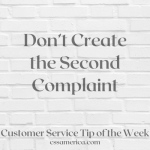With all due respect to the Commodores’ great song (“You’re Once, Twice, Three Times a Lady”), this blog post focuses on gaining repeat business. Many companies work so hard on making the initial sale and celebrating the transaction. But what if we looked at each sale or at each “moment of truth” with the customer not as a single event? What if we saw it as a link to the next sale? The idea is to string together 1, 2, and 3 sales to the same customer. This is creating a customer from a transaction. Several things would be different:
- You would be more concerned with whether the customer was satisfied with the shopping experience.
- You’d be more likely to ask for improvement suggestions.
- You’d be more likely to follow-up after the sale.
- You’d be more likely to set-up periodic customer “touch points” to make sure you’re top-of-mind the next time a buying decision is made.
- You’d be more likely to get contact information on the customer and to use it.
- You’d be more likely to inquire about other customer needs/wants.
- You’d be more concerned with getting to know the customer personally.
- You’d spend more time talking with co-workers about strategies to keep that customer and bring them back.
Think about the customer by thinking about how to get to the next encounter. Turn your transactions into Once, Twice, Three Times a Customer.
Interested in improving your company’s customer service? See more information at: http://www.cssamerica.com/





















